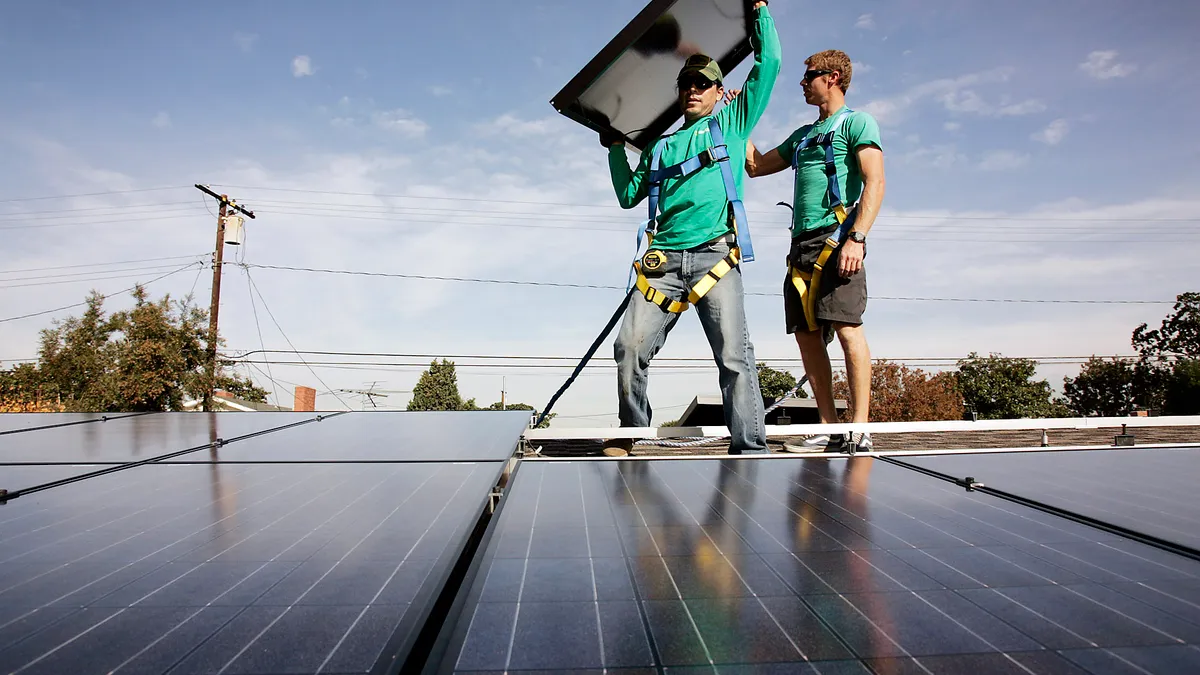Interest in residential energy storage is rising in the U.S., especially when combined with rooftop solar. A new report by EnergySage found that in 2017, 74% of solar shoppers surveyed said they were also considering a home battery system.
While acknowledging that interest has yet to translate into an equivalent sales volume, the EnergySage report said, “batteries present a massive new market opportunity for installers, manufacturers, lenders, and utilities to capitalize on in coming years.”
“It is important to qualify what they are saying,” Brett Simon, senior energy storage analyst at GTM Research, told Utility Dive. People are more frequently asking about energy storage, but interest doesn’t always convert to deployment, he noted.
“In reality, less than 10% of solar installations have storage,” Simon said, but the numbers are likely to grow quickly.
GTM Research predicts that the market for U.S. residential storage will grow fourfold in 2018, Simon said. GTM recorded 19 MW of residential energy storage installations in 2017 and expects to see 74 MW in 2018. Most of that growth – about 95% – will be storage tied to a solar power installation, but large scale aggregation will also play a role, Simon said.
Solar companies offering storage
In the report, EnergySage attributed the growing interest in energy storage among solar purchasers to several factors, including the fact that more solar companies are offering energy storage as an option and to changes in utility incentives and rate structures.
Sunnova in March launched SunSafe, its new solar-plus-storage service, making it the latest company to add storage to its offerings. Vivint Solar last year teamed up with Mercedes Benz to offer the automakers' batteries for solar customers. And Tesla offers its Powerwall battery in conjunction with solar panels installed by its SolarCity subsidiary.
In December, Sunrun began its BrightBox solar-plus-storage service in California and in March said that, so far this year, 20% of its solar customers in California have chosen to add storage to their solar installations. Sunrun also offers BrightBox in Arizona, Hawaii, Massachusetts, Nevada and New York.
Local economic drivers
“I think the local economics are what’s driving how aggressively solar companies are pushing storage,” Alex Eller, senior energy research analyst at Navigant Research, said in an email. Many vendors offer lower prices in those states to gain market share as there’s much more demand coming from customers, he said.
In some states, such as Colorado, the economics are not yet favorable. For most residential customers, there’s no real value in adding storage as long as there is net metering and not a lot of outages.
But, as solar installations increase, there are a growing number of states that are adjusting their policies for solar power. Hawaii has already ended its net metering program, but it is just one of several states that has either rescinded similar programs or is considering doing so.
California is another notable example. The state is switching from net metering to time of use (TOU) rates, which can make solar-plus-storage more economically viable.
In addition, the California Public Utilities Commission has directed the state’s three investor-owned utilities to transition customers to TOU rates starting in 2019. Pacific Gas and Electric and Southern California Edison have proposed delaying the roll out until 2020 and 2021, respectively, but the transition is still underway. In December, all three IOUs filed their TOU plans with the PUC.
Arizona is also moving to TOU rates, which are also available in Massachusetts.
One of the key drivers in the shift to solar-plus-storage is the effect the growth of solar installations has had on utilities’ load profiles, what is often referred to as the duck curve. As solar power peaks during mid-day, conventional generation sources are backed off, but are then suddenly needed in the evening hours when the sun goes down.
“We are seeing more utilities institute TOU rates, which increases the value of solar self-consumption, as utility net metering programs are ramped down or removed,” Simon said. TOU rates makes self-consumption more attractive by raising rates in the evening, making it attractive to store lower cost solar power for later use.
Other factors
The policies in those states make a good market for companies offering solar-plus-storage products. But other factors are also at play, such as the use of batteries to create virtual power plants.
Lebanon, New Hampshire-based Liberty Utilities is launching a pilot program to install Tesla Powerwall batteries for 300 of its customers. The utility plans to use the batteries to create a virtual power plant.
The New Hampshire program is similar to the one launched by Green Mountain Power in 2016 that also uses Tesla Powerwalls. It is a model that Tesla is deploying on an even larger scale in South Australia. There, Tesla is combining a 5 kW rooftop solar system with a 13.5 kWh battery on as many as 50,000 houses. The result would be a virtual power plant that could provide as much as 250 MW of solar power and 650 MWh of energy storage.
As rooftop solar installations continue to grow and utilities continue to adjust their rates, residential storage will likely become more attractive and prevalent, Simon said. He noted other recent developments such as the announcement in March of an alliance between German storage company Sonnen and technology company Itron to create a residential battery system that is designed to lower customers’ electric bills by maximizing the use of solar power.
Last fall, Sonnen teamed up with construction company Mandalay Homes to build 3,000 homes in Arizona that would be equipped with Sonnen battery systems.
The economics of a stand-alone rooftop solar installation are superior to a solar-plus-storage installation, Simon said, but “the gap is narrower than you might expect. In the future, he said, it is not unreasonable to think that solar-plus-storage could compete directly with a solar-only installation.






















